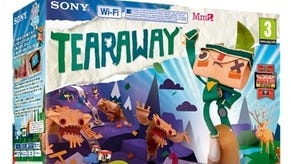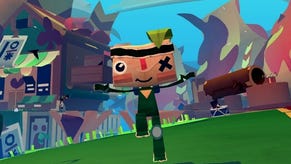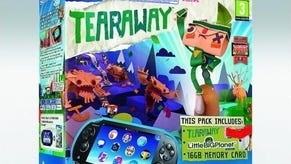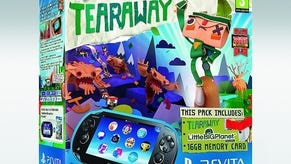Tearaway review
Rustle brand.
It's easy enough to see the visual appeal of Tearaway from screenshots and videos, but to truly appreciate it you need to hold it in your hands. This is an undeniably visual game, but you need to hear the subtle crinkling, flapping and rustling of the paper landscape as you explore. The game looks lovely, but it's those audio touches that glue it all together and sell the illusion.
As with its LittleBigPlanet, Media Molecule has created a game that deftly masks its core of cold ones and zeroes in a warm and tactile aesthetic, all brightly coloured card, streaks of sticky glue and the nostalgic, primary-school snip-snip of scissors purposefully cutting along dotted lines. It feels like you could reach out and touch it.
The twist this time is that you can reach out and touch it. Or at least, you can pretend to, and if you meet the fantasy halfway - or are young enough to be there already - it's utterly beguiling. It's also a game that could only ever work on the Vita, recruiting every single one of its cameras, accelerometers and touchscreens into active service.
The aim is to guide one of two envelope-headed messengers, Iota and Atoi, on a quest to deliver a mystery message to You. Yes, that's You, the player, co-starring in the game as a mysterious entity that suddenly appears as a glowing deity in the sun hanging over this peculiar land. The Vita thus becomes not just a console, but a portal through which you both observe and control your messenger through a land of paper and glue.
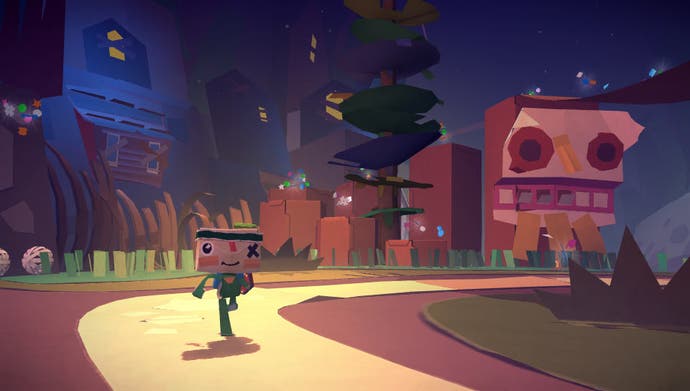
That side of things is familiar from any 3D platformer. What's interesting is that you spend almost as much time reaching into the game and interacting with the world directly as you do guiding Iota or Aoti around directly.
Fingerprint textures highlight objects that can be tugged, unfurled or otherwise moved around with the front touchscreen. Other surfaces carry a faint PlayStation-branded motif, and can be manipulated with the rear touchscreen. A tap from the back might make it bounce like a trampoline, or you can press your fingers on the back of the Vita and have your fingers burst through into the game, knocking enemies known as Scraps out of the way, or moving platforms into position.
They're not really your fingers, of course, but pre-rendered digits that follow your movements. At the start of the game you pick a skin tone and whether you have big hands or small, and the likeness is actually pretty good, considering. Certainly, it made my seven-year-old daughter stare in amazement and turn the Vita upside-down to see if her fingers really had poked through.
That's just the tip of Tearaway's interaction iceberg, however. At certain points, characters will stop you and ask you to make something for them. Your view switches to an artist's cutting board, from where you can drag sheets of paper into the work area, draw shapes with your finger and then cut them out. It's not ideal - creating any really intricate shapes is problematic with your finger - but moving from joypad to touchscreen has really allowed Media Molecule's ingenuity to shine. While it lacks precision, Tearaway's artistic toolset feels more like a smartphone app, intuitive and easy to use, than the nested menus and complex systems of LittleBigPlanet's Pop-It and Creatinator combo. The fact that the things you make look a little rough and wonky simply adds to the "stick it on the fridge door" feel of the game.

Tearaway also understands the importance of seeing your creations at work. One of the first things you're asked to do is make a crown for the Squirrel King. When you encounter him again, hours later, he's still wearing it - every wonky line and imperfect snip on proud display. Hardly a feat of programming genius, but a personal touch that wraps you in the game's snug embrace all the more securely. Every mark you leave on the world gets its moment to shine. You'll design snowflakes that then fill the screen in a papery blizzard, and draw flames that appear in every subsequent fire. If Tearaway has a deeper message, it's that in life as in the game, this is your world, your story; a canvas to be filled.
There's a generosity of spirit here that is heavily player-biased. Tapping and holding your character zooms you in closer, allowing you to redesign their appearance whenever you want - either from pre-made cutouts that you buy with collected confetti pieces, or by dipping back into the art studio to stock the game with your own creations.
You can use an in-game camera, complete with multiple lenses and Instagram-style filters, to take selfies of your character, but also to take actual real-world shots of yourself - and the photos you take are used inventively, weaving into the game world the deeper you go. Not only do you appear peering through your sun portal, but your face - and even your voice - will crop up more and more as the game barrels towards its whimsically poetic conclusion, a kaleidoscope where player and playee become one.
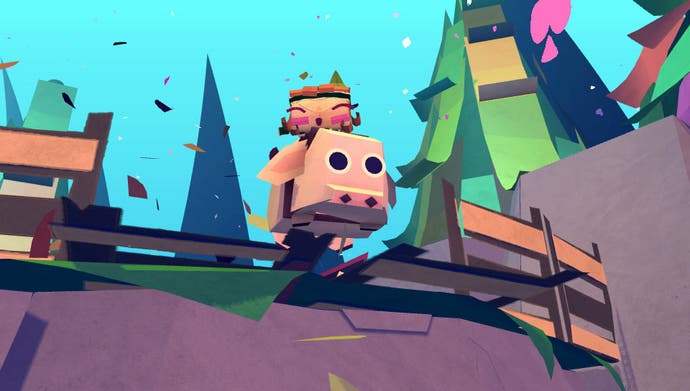
With so much charming, augmented-reality whimsy piled on top, it's easy to forget that there's a traditional action adventure game underneath, and it's here that Tearaway's flaws, minor though they are, can be found.
This is a more open game than Sackboy's side-on shenanigans, but it's still mostly linear in construction, making true exploration a secondary concern, and a lot of the collectables aren't really all that collectable. Each area contains a series of wrapped presents to find, but all these really do is offer bonus confetti. More fun are the plain white objects found lurking in the scenery. Snap these with your camera and you not only colour them back in, but unlock printable papercraft models of the object in question at a dedicated website. As a way of bringing the digital and the real together, it's the perfect example of what Tearaway is all about.
Iota and Aoti start out almost entirely reliant on you to navigate the scenery, but they gain abilities as the game progresses, such as jumping and rolling, as well as a super-charged squeezebox that allows you to suck up enemies and fire them out again, or to blow scenery items to open the way ahead. There are moments where traditional platforming overlaps with the game's more esoteric features, and the result is wonderful. Using your fingers to stem the flow of a paper waterfall so your character can pass is a highlight. Equally there are long passages where, in terms of mechanics at least, you could be playing any decent 3D platformer.
For every section of simple platforming there's a moment of pure creative delight that leaves most other games looking stuffy and sterile, locked away behind their joypads and glass
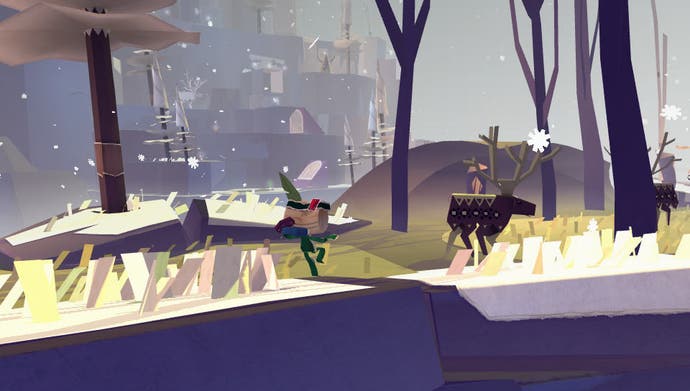
Combat could stand to be stronger too, and while the game periodically locks you into an area while boxy Scraps swarm around until you dispatch them, it never feels like the developer's warm, fuzzy heart is truly invested in this aspect of the gameplay. The action isn't bad, it's just standard dodge-grab-and-throw fare that contrasts badly with the inventiveness elsewhere. You bash enemies because that's what games do. You get the feeling that if there was a way to generate the same excitement from cuddling enemies and making them a nice organic quinoa salad, Media Molecule would have done that instead.
There are also times when the game gets a little too enamoured with the Vita's multiple inputs and control options, leading to sections where you're using sticks and face buttons, as well as both touchscreens, and it becomes a frustrating fumble. The camera isn't great, and a reliance on some cheap instant kill obstacles makes this otherwise perfectly kid-friendly game just a little too annoying for youngsters to play alone.
These complaints are fleeting in nature and don't do much to dim Tearaway's enchanting glow, however. They certainly won't stop you reaching the end. It's not a long game, but for every section of simple platforming there's a moment of pure creative delight that leaves most other games looking stuffy and sterile, locked away behind their joypads and glass, away from your prodding, inquisitive fingers. Tearaway's tactile world may be no more real, but while you're under its spell it certainly doesn't feel that way.





